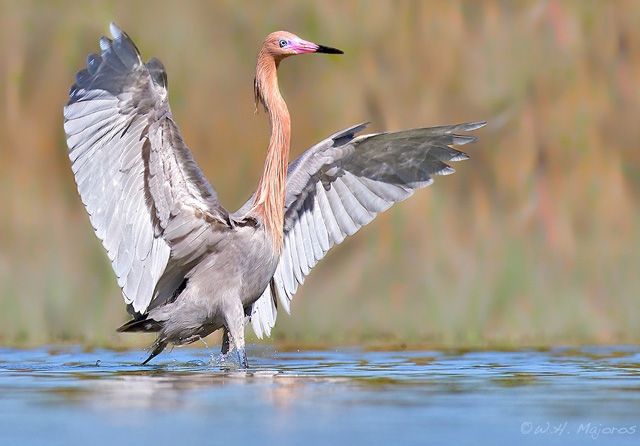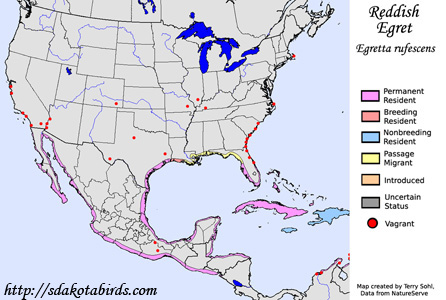| Length: 30 inches | Wingspan: 46 inches | Seasonality: Non-resident in South Dakota |
| ID Keys: Dark morph (pictured below) has reddish neck and head, with bluish-gray body. White morph has all white plumage. Both have bi-colored bill. | ||
 The
Reddish Egret is a bird of salt water, rarely being found away from coastal
areas. In the U.S., they are primarily found along the Gulf coast, but
their populations are scattered. Most birds in the U.S. breed in
either Texas or Florida, with very different breeding habitats between the
two locations (see below). They have two color morphs, a white morph
with all white plumage, and a dark morph (pictured to the right).
Reddish Egrets sometimes use a foraging technique pictured by the bird on
the right. They will stand perfectly still and spread their wings to
create shade, which attracts small fish that the Reddish Egret then feeds
upon.
The
Reddish Egret is a bird of salt water, rarely being found away from coastal
areas. In the U.S., they are primarily found along the Gulf coast, but
their populations are scattered. Most birds in the U.S. breed in
either Texas or Florida, with very different breeding habitats between the
two locations (see below). They have two color morphs, a white morph
with all white plumage, and a dark morph (pictured to the right).
Reddish Egrets sometimes use a foraging technique pictured by the bird on
the right. They will stand perfectly still and spread their wings to
create shade, which attracts small fish that the Reddish Egret then feeds
upon.
Habitat: A salt-water species, found in protected coastal habitats along the Gulf coast in the U.S., more rarely along the Atlantic coast or Pacific coast. Nesting habitat is primarily mangrove forests in Florida, and offshore islands with a thorny scrub cover in Texas.
Diet: Feeds mostly on fish, but will also feed on crustaceans, frogs, and tadpoles.
Behavior: Forages by walking through shallow water. As noted above, will sometimes stand still with wings spread, with shade attracting small fish.
Nesting: A colonial breeder. The nest of a Reddish Egret is a platform of sticks and other vegetation, placed on the ground, or low in mangroves in their Florida breeding range. The female usually lays 3 or 4 eggs, and both parents help to incubate them. After the eggs hatch, both parents help to feed them. The young leave the nest after about a month, but are still cared for by the parent until they can fly, about 2 or 3 weeks later.
Song: Not a very vocal species. The call of a Reddish Egret is a muted groaning with a short grunt.
Migration: Most birds appear to be permanent residents. However, some birds in Texas move south for the winter, while others may wander along the Gulf and Atlantic coasts. In the western U.S., birds from Baja California sometimes wander northward along the California coast.
Interactive eBird Map: Click here to access an interactive eBird map of Reddish Egret sightings
Similar Species: White morph can be confused with Great Egret or Snowy Egret. Of those 3 species, the Reddish Egret is intermediate in size. Dark morph possibly confused with Tricolored Heron, although plumage differences are obvious if seen well.
Conservation Status: While populations of the Reddish Egret are spread over a wide geographic region, they are scattered and local and have an overall low population. The species also appears to be declining in number. The IUCN lists the Reddish Egret as a "Near Threatened" species.
Further Information: 1) Texas Parks and Wildlife - Reddish Egret
2) Audubon Guide - Reddish Egret
3) Field Guide to the Rare Animals of Florida - Reddish Egret
Photo Information: Photo taken by Bill Majoros - August 6th, 2009 - Fort Desoto, Florida - Photo licensed under Creative Commons Attribution ShareAlike 2.0 Generic License.
| Click below for a higher-resolution map |
 |
| South Dakota Status: Non-resident in South Dakota |
Additional Reddish Egret Photos (coming soon!!)
